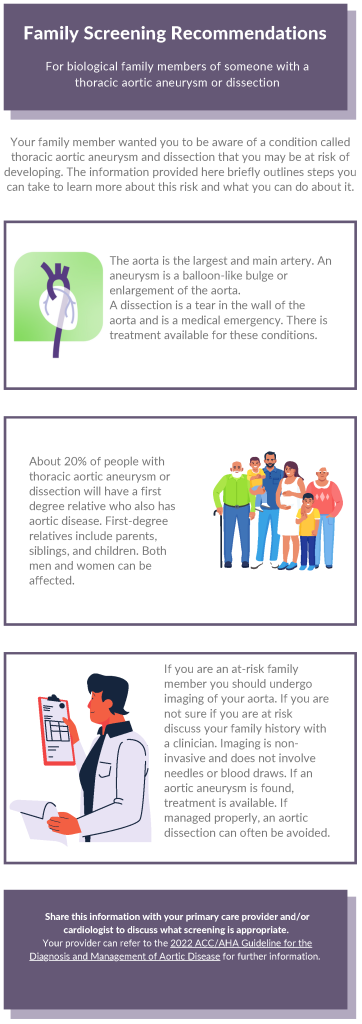Family Screening Guide
If a family member is diagnosed with a thoracic aortic aneurysms or aortic dissection, other family members related by blood may also be at risk to develop thoracic aortic aneurysms or dissections. Genetic counseling, imaging for asymptomatic aortic aneurysms, and genetic testing can be used to identify other family members at risk for thoracic aortic disease.
Screening Guide Recommendations
Your family member wanted you to be aware of a condition called thoracic aortic aneurysm and dissection that you may be at risk of developing. The information provided here briefly outlines steps you can take to learn more about this risk and what you can do about it.
The aorta is the largest and main artery. An aneurysm is a balloon-like bulge or enlargement of the aorta. A dissection is a tear in the wall of the aorta and is a medical emergency. There is treatment available for these conditions.
About 20% of people with thoracic aortic aneurysm or dissection will have a first degree relative who also has aortic disease. First-degree relatives include parents, siblings, and children. Both men and women can be affected.
If you are an at risk family member you should undergo imaging of your aorta. If you are not sure if you are at risk discuss your family history with a clinician. Imaging is non- invasive and does not involve needles or blood draws. If an aortic aneurysm is found, treatment is available. If managed properly, an aortic dissection can often be avoided.
Next Steps
Share this information with your primary care provider and/or cardiologist to discuss what screening is appropriate.
Your provider can refer to the 2022 ACC/AHA Guideline for the Diagnosis and Management of Aortic Disease further information.


